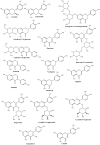Pistachio Nuts (Pistacia vera L.): Production, Nutrients, Bioactives and Novel Health Effects
- PMID: 35009022
- PMCID: PMC8747606
- DOI: 10.3390/plants11010018
Pistachio Nuts (Pistacia vera L.): Production, Nutrients, Bioactives and Novel Health Effects
Abstract
Epidemiological and clinical studies have indicated positive outcomes related to tree nut consumption. Here, we review the production, nutrient, phytochemical composition and emerging research trends on the health benefits of pistachio nuts (Pistacia vera L.). Pistachios are a good source of protein, fiber, monounsaturated fatty acids, minerals and vitamins, as well as carotenoids, phenolic acids, flavonoids and anthocyanins. Polyphenols in pistachios are important contributors to the antioxidant and anti-inflammatory effect, as demonstrated in vitro and in vivo through animal studies and clinical trials. The antimicrobial and antiviral potential of pistachio polyphenols has also been assessed and could help overcome drug resistance. Pistachio consumption may play a role in cognitive function and has been associated with a positive modulation of the human gut microbiota and beneficial effects on skin health. Pistachio polyphenol extracts may affect enzymes involved in glucose regulation and so type 2 diabetes. Taken together, these data demonstrate the health benefits of including pistachios in the diet. Further studies are required to investigate the mechanisms involved.
Keywords: flavonoids; health effects; nuts; pistachio; polyphenols; production.
Conflict of interest statement
A.C., M.A.R. and M.J.F. are consultants for the American Pistachio Growers (APG). APG had no role in the writing of the manuscript or in the decision to publish the finished paper.
Figures




Similar articles
-
Pistacia vera L. as natural source against antimicrobial and antiviral resistance.Front Microbiol. 2024 Jul 1;15:1396514. doi: 10.3389/fmicb.2024.1396514. eCollection 2024. Front Microbiol. 2024. PMID: 39011148 Free PMC article. Review.
-
Antioxidant activity and phenolic profile of pistachio (Pistacia vera L., variety Bronte) seeds and skins.Biochimie. 2010 Sep;92(9):1115-22. doi: 10.1016/j.biochi.2010.03.027. Epub 2010 Apr 11. Biochimie. 2010. PMID: 20388531
-
Fulvic acid foliar application: a novel approach enhancing antioxidant capacity and nutritional quality of pistachio (Pistacia vera L.).BMC Plant Biol. 2024 Apr 4;24(1):241. doi: 10.1186/s12870-024-04974-0. BMC Plant Biol. 2024. PMID: 38570771 Free PMC article.
-
Quantification and bioaccessibility of california pistachio bioactives.J Agric Food Chem. 2014 Feb 19;62(7):1550-6. doi: 10.1021/jf4046864. Epub 2014 Feb 10. J Agric Food Chem. 2014. PMID: 24460079
-
Effect of chronic consumption of pistachios (Pistacia vera L.) on glucose metabolism in pre-diabetics and type 2 diabetics: A systematic review.Crit Rev Food Sci Nutr. 2019;59(7):1115-1123. doi: 10.1080/10408398.2017.1392290. Epub 2017 Nov 13. Crit Rev Food Sci Nutr. 2019. PMID: 29040025
Cited by
-
Tracing pistachio nuts' origin and irrigation practices through hyperspectral imaging.Curr Res Food Sci. 2024 Sep 5;9:100835. doi: 10.1016/j.crfs.2024.100835. eCollection 2024. Curr Res Food Sci. 2024. PMID: 39309406 Free PMC article.
-
Beyond the Nut: Pistacia Leaves as Natural Food Preservatives.Foods. 2024 Sep 30;13(19):3138. doi: 10.3390/foods13193138. Foods. 2024. PMID: 39410171 Free PMC article. Review.
-
Immunometabolism Modulation by Extracts from Pistachio Stalks Formulated in Phospholipid Vesicles.Pharmaceutics. 2023 May 19;15(5):1540. doi: 10.3390/pharmaceutics15051540. Pharmaceutics. 2023. PMID: 37242782 Free PMC article.
-
Effect of In Vitro Gastrointestinal Digestion and Colonic Fermentation on the Stability of Polyphenols in Pistachio (Pistacia Vera L.).Int J Mol Sci. 2023 Mar 4;24(5):4975. doi: 10.3390/ijms24054975. Int J Mol Sci. 2023. PMID: 36902411 Free PMC article.
-
Pharmacological Potential of Bioactive Peptides for the Treatment of Diseases Associated with Alzheimer's and Brain Disorders.Curr Mol Med. 2024;24(8):962-979. doi: 10.2174/1566524023666230907115753. Curr Mol Med. 2024. PMID: 37691200 Review.
References
-
- Ferguson L., Polito V., Kallsen C. Pistachio Production Manual. 4th ed. University of California, Fruit & Nut Research Information Center; Davis, CA, USA: 2005. The pistachio tree. Botany and physiology and factors that affect yield.
-
- Barghchi M., Alderson P.G. Pistachio (Pistacia vera L.) In: Bajaj Y.P.S., editor. Biotechnology in Agriculture and Forestry, Trees II. Springer; Berlin/Heidelberg, Germany: 1989. pp. 68–98. - DOI
-
- Saitta M., Giuffrida D., di Bella G., La Torre L., Dugo G. Compounds with antioxidant properties in pistachios (Pistacia vera L.) Seeds. In: Preedy V.R., Watson R.R., Patel V.D., editors. Nuts and Seeds in Health and Disease Prevention. Elsevier Inc.; Amsterdam, The Netherlands: 2011.
-
- Monnier G. Neanderthal behaviour. Nat. Educ. Knowl. 2012;3:11.
-
- Brothwell D., Brothwell P. Food in Antiquity, a Survey of the Diet of Early Peoples. The John Hopkins University Press; London, UK: 1969. Fruits and nuts.
Publication types
LinkOut - more resources
Full Text Sources
Medical

